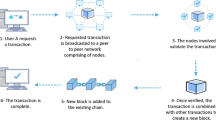Abstract
Governments and industry leaders have already carried out programs to fully evaluate the strengths of blockchain and how it needs to be incorporated into everyday practices. Several segments performed faster than others. The integration of blockchain technologies into everyday activities within large multinationals was officially communicated, with the money part being the snappiest out of the squares, the promotion and the market part. Where integration of blockchain technologies can provide secure, accessible digital versions to all parties in a transaction, and smart contracts can be used to manage the workflow of approvals and automatically transfer payment upon all signatures being collected. As indicated by Gartner, blockchain innovation has just reached the height of the advertisement process and entered a time of decline, which is recognizing the authenticity of blockchain innovation. The perspective for innovation in blockchain looks magnificent and the increases created by acquiring the innovation are unforeseen. The general consensus is that passing the time of swelled desire was a significant advance in the transformation of blockchain across the infomercial process. The viewpoint for blockchain innovation looks splendid and the increases produced using receiving the innovation will be inconceivable. How the innovation is grasped will be the way to how it benefits the monetary markets and the world when all is said in done.










Similar content being viewed by others
References
Biswas, K., & Muthukkumarasamy, V. (2016). Securing smart cities using blockchain technology. In Proceedings of IEEE 18th international conference high perform. computing communication IEEE 14th international conference smart City, IEEE 2nd international conference data science system (HPCC/SmartCity/DSS) (pp. 1392–1393).
Chaudhry, S. A., Alhakami, H., Baz, A., & Al-Turjman, F. (2020). Securing demand response management: A certificate-based access control in smart grid edge computing infrastructure. IEEE Access, 8, 101235–101243. https://doi.org/10.1109/ACCESS.2020.2996093.
Chithaluru, P., Al-Turjman, F., Kumar, M., & Stephan, T. (2020). I-AREOR: An energy-balanced clustering protocol for implementing green IoT for smart cities. In Sustainable cities and society (p. 102254). https://doi.org/10.1016/j.scs.2020.102254
Courtois, N. T., & Mercer, R. (2017). Stealth address and key management techniques in blockchain systems. In Proceedings pf ICIS-SP (pp. 559–66).
Deebak, B. D., & Al-Turjman, F. (2020). A hybrid secure routing and monitoring mechanism in IoT-based wireless sensor networks. Ad Hoc Networking, vol. 97, ISSN 1570-8705, https://doi.org/10.1016/j.adhoc.2019.102022
Ethan, H., Baldimtsi, F., Alshenibr, L., Scafuro, A., & Goldberg, S. (2017). Tum- bleBit: an untrusted tumbler for bitcoin-compatible anonymous pay- ments. In Proceedings of network distributed system security symposium (NDSS) (pp. 1–15). San Diego, CA, USA.
Han, J., Kim, S., & Jang, M. (2020). Using genetic algorithm and NARX neural network to forecast daily bitcoin price. Computing Economy, 56, 337–353. https://doi.org/10.1007/s10614-019-09928-5.
Hasan, H. R., & Salah, K. (2018a). Blockchain-based solution for proof of delivery of physical assets. Blockchain (Vol. 10974, pp. 139–152)., Lecture Notes in Computer Science Seattle: Springer.
Hasan, H., & Salah, K. (2018b). Proof of delivery of digital assets using blockchain and smart contracts. IEEE Access, 5, 65439–65448.
Heilman, E., Baldimtsi, F., Goldberg, S. (2016). Blindly signed contracts: anonymous on-blockchain and off-blockchain bitcoin transactions. In Financial cryptography and data security (pp. 43–60). Berlin, Germany: Springer.
Kang, S. H., Yoon, S., & Bekiros, S. (2020). Bitcoin as hedge or safe haven: evidence from stock, currency, bond and derivatives markets. Computing Economy, 56, 529–545. https://doi.org/10.1007/s10614-019-09935-6.
Kumar, M., Alshehri, M., AlGhamdi, R., Sharma, P., & Deep, V. (2020). A DE-ANN inspired skin cancer detection approach using fuzzy C-means clustering. In Mobile network and applications (Springer). https://doi.org/10.1007/s11036-020-01550-2.
Liu, J., Li, W., Karame, G., & Asokan, N. (2018). Toward fairness of cryptocur-rency payments. IEEE Security Privacy, 26, 81–89.
Liu, Y., Zhang, W., & Fu, J. (2020). Multifractal analysis of realized volatilities in chinese stock market. Computing Economcy, 56, 319–336. https://doi.org/10.1007/s10614-019-09920-z.
Mut-Puigserver, M., Payeras-Capellà, M., & Cabot-Nadal, M. (2018). Blockchain-based fair certified notifications. In Data privacy management, cryptocurrencies and blockchain technology (pp. 20–37), Lecture Notes in Computer Science, vol. 11025. Barcelona, Spain: Springer
Ruffing, T., & Pedro, M. –S. (2017). ValueShuffle: mixing confiden- tial transactions for comprehensive transaction privacy in bitcoin. In Proceedings of international conference financial cryptography and data security (pp. 133–54). Springer, Cham.
Sun, S. F. et al. (2017). RingCT 2.0: A compact accumulator-based (linkable ring signature) protocol for blockchain cryptocur- rency monero. In Proceedings European symposium on research in computer security (pp. 456–74). Springer, Cham.
Valenta, L., & Rowan, B. (2015). Blindcoin: blinded, accountable mixes for bitcoin. In Proceedings of international conference financial cryptography and data security (pp 112–26). Springer, Berlin, Heidelberg.
Acknowledgements
The author would like to express his sincere thanks to the editor-in-chief for his valuable suggestions to improve this article.
Author information
Authors and Affiliations
Corresponding author
Additional information
Publisher's Note
Springer Nature remains neutral with regard to jurisdictional claims in published maps and institutional affiliations.
Rights and permissions
About this article
Cite this article
Yadav, S.P., Agrawal, K.K., Bhati, B.S. et al. Blockchain-Based Cryptocurrency Regulation: An Overview. Comput Econ 59, 1659–1675 (2022). https://doi.org/10.1007/s10614-020-10050-0
Accepted:
Published:
Issue Date:
DOI: https://doi.org/10.1007/s10614-020-10050-0




